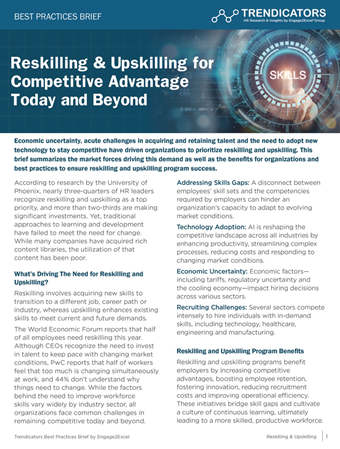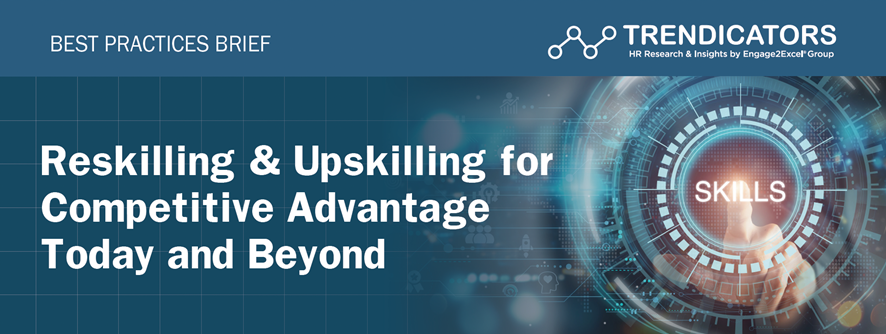Reskilling & Upskilling for Competitive Advantage Today and Beyond


Economic uncertainty, acute challenges in acquiring and retaining talent and the need to adopt new technology to stay competitive have driven organizations to prioritize reskilling and upskilling. This brief summarizes the market forces driving this demand as well as the benefits for organizations and best practices to ensure reskilling and upskilling program success.
According to research by the University of Phoenix, nearly three-quarters of HR leaders recognize reskilling and upskilling as a top priority, and more than two-thirds are making significant investments. Yet, traditional approaches to learning and development have failed to meet the need for change. While many companies have acquired rich content libraries, the utilization of that content has been poor.
What’s Driving The Need for Reskilling and Upskilling?
Reskilling involves acquiring new skills to transition to a different job, career path or industry, whereas upskilling enhances existing skills to meet current and future demands.
The World Economic Forum reports that half of all employees need reskilling this year. Although CEOs recognize the need to invest in talent to keep pace with changing market conditions, PwC reports that half of workers feel that too much is changing simultaneously at work, and 44% don’t understand why things need to change. While the factors behind the need to improve workforce skills vary widely by industry sector, all organizations face common challenges in remaining competitive today and beyond.
Addressing Skills Gaps: A disconnect between employees’ skill sets and the competencies required by employers can hinder an organization’s capacity to adapt to evolving market conditions.
Technology Adoption: AI is reshaping the competitive landscape across all industries by enhancing productivity, streamlining complex processes, reducing costs and responding to changing market conditions.
Economic Uncertainty: Economic factors—including tariffs, regulatory uncertainty and the cooling economy—impact hiring decisions across various sectors.
Recruiting Challenges: Several sectors compete intensely to hire individuals with in-demand skills, including technology, healthcare, engineering and manufacturing.
Reskilling and Upskilling Program Benefits
Reskilling and upskilling programs benefit employers by increasing competitive advantages, boosting employee retention, fostering innovation, reducing recruitment costs and improving operational efficiency. These initiatives bridge skill gaps and cultivate a culture of continuous learning, ultimately leading to a more skilled, productive workforce.
Download
 hbspt.cta.load(123973, 'aacf8385-24f6-40f3-ae39-59eff86d116a', {"useNewLoader":"true","region":"na1"});
hbspt.cta.load(123973, 'aacf8385-24f6-40f3-ae39-59eff86d116a', {"useNewLoader":"true","region":"na1"});
Best Practices for Reskilling & Upskilling Initiatives
![]()
Skills Gap Analysis: A comprehensive analysis is needed to identify the discrepancy between current employee skills and those required for their roles and future organizational needs. This includes evaluating individual competencies, pinpointing areas of deficiency and prioritizing skill development initiatives.
Skills Inventory: For key job roles, create a list of current skills and those needed for future projects.
Performance Data: Analyze performance data, including manager feedback, to identify skill gaps.
Skills Assessments: Utilize skills assessments and surveys to measure employee skills and identify areas of strength and weakness.
![]()
Upskilling and Reskilling: Offer a range of development programs, including formal training, workshops, e-learning and on-the-job training.
Personalized Learning: Create individual learning plans that align with employee aspirations and organizational needs.
Learning Technology: Leverage technology to enable personalized learning journeys.
Cross-Training: Encourage employees to learn multiple aspects of the organization beyond their current roles.
Mentoring and Coaching: Establish mentorship programs in which seasoned employees guide less experienced ones.
Strategic Partnerships: Partner with external training organizations for relevant and up-to-date training.
![]()
Contract Workers and Project Teams: Hire temporary professionals for specific projects.
Outsourcing: Outsource peripheral functions to focus on core competencies.
New Hires: Invest in new talent for long-term projects.
Skills-Based Hiring: Rethink hiring criteria to promote diversity and adaptability.
![]()
Continuous Learning: Foster a culture that values continuous improvement and lifelong learning.
Collaborative Learning: Encourage knowledge sharing and collaborative learning.
Leadership Development: Identify and support future leaders.
![]()
Formal Recognition Programs: Implement formal recognition programs to acknowledge specific achievements related to reskilling and upskilling.
Public Shout-Outs: Feature employee accomplishments and newly acquired skills in company newsletters, intranet pages or internal communications.
Peer Recognition: Encourage colleagues to recognize one another’s learning and development efforts.
Milestone Celebrations: Recognize employees for achieving specific milestones in their learning journey, such as completing a course, obtaining a certification or successfully applying new skills on the job.
Trendicators™ is the research division of the E2E group of companies, leading providers of engaging career and consumer experiences. Trendicators provides original research and reports on insights and best practices from industry leaders and experts.
Download
 hbspt.cta.load(123973, 'aacf8385-24f6-40f3-ae39-59eff86d116a', {"useNewLoader":"true","region":"na1"});
hbspt.cta.load(123973, 'aacf8385-24f6-40f3-ae39-59eff86d116a', {"useNewLoader":"true","region":"na1"});